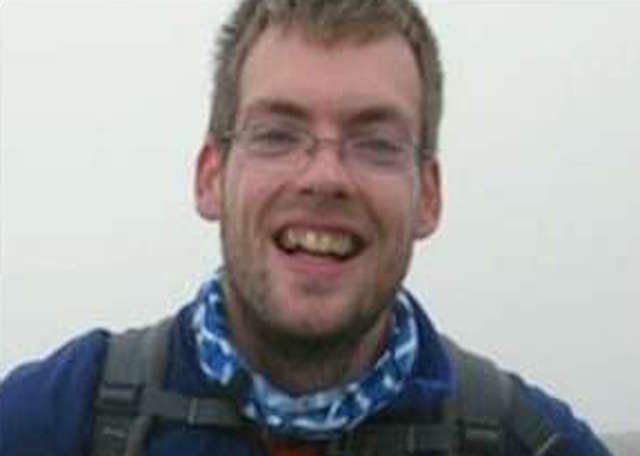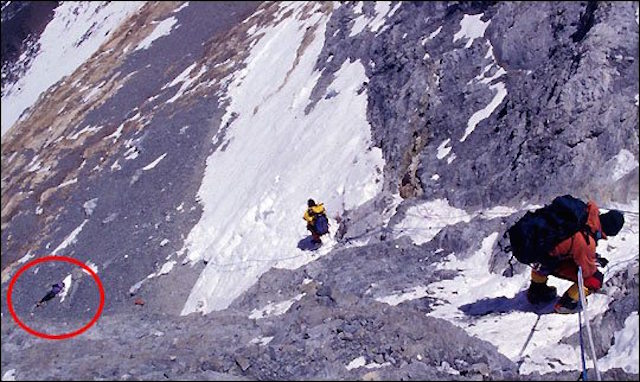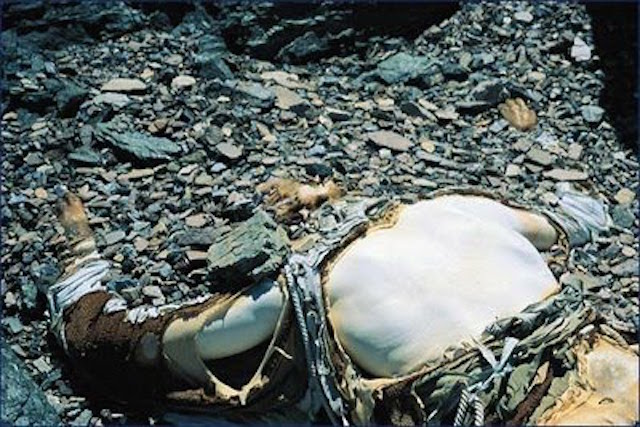A problem with dying on Mount Everest is that there’s a good chance you’ll stay on the mountain, as it’s simply too hard and dangerous to retrieve dead bodies. This is especially true near the summit, which is also the most dangerous leg of the climb. That means when climbers attempt to scale the world’s highest mountain, they’ll come across some of these bodies. But what’s morbidly fascinating is that these bodies are often used as distance markers to the summit.
10. Karl Gordon Henize
Karl Gordon Henize was born on October 17, 1926, in Cincinnati, Ohio, and as an adult, he was a professor of astronomy at Northwestern University. In 1967, NASA selected him to be a scientist-astronaut. In 1985, he went into space on the Challenger shuttle as one of the astronauts for Spacelab-2, making him the oldest American to go into space at the time.
Outside of his scientific work, one of Henize’s passions was mountain climbing. In October of 1993, the 66-year-old was attempting to reach the summit of Mount Everest, where he wanted to test a tool from NASA for measuring radiation. Sadly, Henize died from high altitude cerebral edema at base camp on October 5. As per his wishes, he was buried in the mountainside, where his body remains.
9. Peter Kinloch
It had been a lifelong dream of British IT specialist Peter Kinloch to climb the famous seven summits, which is when a mountain climber reaches the summit of the tallest mountain on each continent. On May 1, 2010, at about 1:00 p.m. the 28-year-old reached the summit of his fifth mountain, Mount Everest, and started to make his way back down. That’s when he started to show symptoms of high altitude cerebral edema, which is the swelling of the brain that happens at high altitudes. He was having trouble seeing, before eventually going blind. Three Sherpas and a team leader helped Kinloch for 12 hours by giving him medicine and oxygen and then tried to lead the blind man down the mountain. Sadly, they couldn’t do enough and the weather became worse, so they were forced to abandon Kinloch at about 28,000 feet, where he eventually died.
A year later, a friend of Kinloch’s climbed Everest and saw the body of his dead friend. His body was tied to the mountainside by the Sherpas before he died, so it’s likely that he will remain there for the foreseeable future. His friend said that Kinloch body looked like it was frozen solid, but he looked peaceful, like he was lying down and taking a nap.
8. Marty Hoey
In 1982, 31-year-old Marty Hoey was working as a safety patrol chief at a ski resort in Utah when she took a vacation to go on an expedition with 16 men to climb the north face of Mount Everest. On May 15, 1982, at about 5:30 p.m., Hoey was climbing up a steep part of the mountain at about 26,600 feet, when her safety buckle came undone. Hoey’s friends and teammates could do nothing for her as they watched her plummet 6,000 feet to her death.
After the fall, the men were hit by bad weather and said that Hoey’s death was a major blow to their morale. They were forced to turn around before they reached the summit. Hoey’s body was never recovered.
7. Francys and Sergei Arsentiev
American mountain climber Francys Arsentiev and her husband Sergei Arsentiev travelled to the Mount Everest base camp in May of 1998. They tried to reach the summit twice, but both times were forced to turn back. On May 22, they made their third attempt to reach the top of the mountain and amazingly, they reached the summit without using oxygen tanks. But during their descent on the night of May 23, Francys and Sergei became separated from one another. When Sergei came across another team of climbers, he found out that his wife had not passed them. He asked them for oxygen and medicine, then he went back to find his wife. He was never seen again.
As for Francys, she was spotted by climbers Ian Woodall and his then-future wife, Cathy O’Dowd, on the morning of May 24. She was slowly freezing to death and was suffering from exhaustion. She begged for help, but there was nothing Woodall and O’Dowd could do. They spent some time with her before being forced to leave her to die because of bad weather. Francys’ last words were, “Don’t leave me here to die.”
Woodall and O’Dowd continued on to the summit, but were haunted for years by their interaction with the 40-year-old mother of one. In 2007, almost 10 years later, Woodall and O’Dowd returned to Francys’ body and buried her.
6. David Sharp
In May of 2006, 34-year-old British mountain climber David Sharp was attempting to climb Mount Everest alone with only two tanks of oxygen. It’s believed that he reached the summit on May 15, but then on his descent, he ran into trouble and was forced to seek shelter in a small alcove called “Green Boots Cave.”
While he was hiding and slowly dying from exposure, at least 40 climbers, both ascending and descending, passed Sharp and did not help him. This included Mark Inglis, who was the first ever double amputee to climb the mountain. In an interview, Inglis said that when he came across Sharp, he couldn’t even walk. The incident sparked controversy over what responsibilities, if any, do climbers have when it comes to aiding other climbers who are in peril.
5. Hannelore Schmatz
On October 2, 1979, 39-year-old Hannelore Schmatz and her team led by her husband, had reached the summit of Mount Everest via the southern route. On their way down, the expedition was forced to stop about 100 meters short of Camp IV (there are four camps before the summit), where Schmatz collapsed and died from exhaustion. Another climber, American Ray Genet, also died, but the rest of the team survived.
In the ensuing years, Schmatz’s body haunted people climbing the southern route. Her body was recognizable because it appeared to be sitting casually, still dressed in the clothes she died in. Also, even though she was dead, her eyes were open and her hair would blow in the wind. In 1984, a Nepalese police officer and a Sherpa tried to move Schmatz’s body, but they died in the process. After about 20 years, the wind pushed Schmatz’s body into a valley below where it remains to this day.
4. George Mallory
George Mallory was a British schoolteacher who was born in 1886. A naturally gifted mountain climber, he often climbed in the Alps and Wales. In 1921 and 1922, he was part of two of the first major expeditions to climb Everest. The first one in 1921 was more to map out the mountain and the second expedition a year later came to an end after an avalanche killed seven people on Mallory’s team.
In 1924, Mallory was chosen for a third expedition. Just before he was about to set off, Mallory was asked why would anyone want to climb Everest and he famously replied, “Because it’s there.” On June 6, Mallory and another mountain climber named Andrew Irvine started their ascent and by June 8th, they had reached an altitude of 26,800 feet (the highest peak of Everest is 29,029 ft). They set off on the morning of June 8 to the summit and that was the last time that anyone saw them alive. It’s unclear if Mallory and/or Irvine reached the peak. Mallory’s body was found in 1975 by Chinese climbers at 26,760 feet, but Irvine’s body was never found. It’s believed that Mallory died from a bad fall. His body is still relatively well preserved, considering his body has been lying there for over 90 years. Everest wouldn’t be conquered until 1953, when Sir Edmund Hillary and Tenzing Norgay reached the summit.
3. Rob Hall
In May of 1996, experienced mountain climber and New Zealand native Rob Hall was leading a team of eight amateur mountain climbers to the summit of Mount Everest. Beside Hall’s team, there were three other expedition teams near the summit on the afternoon of May 11. Around 4:30 p.m., one of the people Hall was leading collapsed and Hall stayed to help. But the weather had taken a turn for the nightmarish when a storm blew in and trapped some of the climbers, including Hall, at the top of the mountain.
Stranded in a blizzard at 28,500 feet, Hall survived the night, but wouldn’t survive the day. In the afternoon of May 12, Hall had a satellite phone and used it to call his wife, who was pregnant with the couple’s first child. The last words he said to her were, “”I love you. Sleep well, my sweetheart. Please don’t worry too much.” Then the phone went silent.
Hall’s body is still on the South ridge of the mountain, but has fallen over 12,000 feet, where his widow wants him to stay. She doesn’t feel that her husband would want someone risking their life to remove his body. Hall was one of eight people to die during the blizzard and it was one of the deadliest days on the mountain. The disaster was the basis of the bestselling book, Into Thin Air, by Jim Krauker, who was one of the members of Hall’s team that had reached the summit the day prior. Hall is also the main character of the film Everest, which opened this past weekend. Uh, spoiler alert, we guess?
2. “Green Boots”
Probably the most famous body that’s used as a marker is a body called “Green Boots,” located on the Northeast ridge near a limestone alcove at about 28,000 feet, which we mentioned in the entry about David Sharp. The body’s nickname comes from the green mountaineering boots that are still on the body’s feet.
It’s believed that the body is that of an Indian man named Tsewang Paljor, who was seen wearing green boots when he and his six man team climbed the mountain in 1996. On May 11, they were hit by the same blizzard that was responsible for the death of Rob Hall. Paljor and two of his teammates continued up the summit, while the other three turned around. Apparently Paljor and his teammates reached the summit and radioed down to the base, saying that they had accomplished their mission. However, this is highly debated.
On the descent, Paljor hid in the cave from the elements, but he ultimately died from exposure in the cave while wearing the distinct boots.
1. The Rainbow Valley
The Rainbow Valley sounds like a majestic and peaceful place on paper, but in reality, it’s a scene from a horror movie. Everest’s Rainbow Valley is located at about the 26,000 foot mark and it can be seen by people using the Northeast ridge route to reach the summit. The valley is actually full of dead bodies, and the rainbow is made up of the colors of the bright jackets and snowsuits that cling to the bodies. The valley has so many dead people because climbers who come across a corpse will either push them into the valley or cut bodies down if they are hung up on ropes. One of the bodies near the valley is that of George Mallory.
The Rainbow Valley is one of the largest active mass graves in the world because people die every single year trying to climb the world’s tallest mountain.
Robert Grimminck is a Canadian freelance writer. You can friend him on Facebook, follow him on Twitter, follow him on Pinterest or visit his website.









6 Comments
Everest 1996 disaster was one of the tragedy event in Everest history.Rob hall was one of them who lost his life.Along with him there were list of expedition teams who died:The Adventure Consultants was led by Rob hall with two other guides
Rob hall- Expedition leader,Mike Groom and Andy Harris.
Climbers who lost their lives during that day:
Rob Hall, Andy Harris, Yasuko Namba, Scott Fischer, TsewangSamanla, TsewangPaljor, DorjeMorup, Jon Krakauer, Neal Beidleman, Michael Groom, LeneGammelgaard, Stuart Hutchison, Sandy Hill Pittman, Beck Weathers and Lou Kasischke.
On May 10-11 1996,this is one of the worst disasters occurred on Mount Everest. It would be recorded as a tragic date in the history of mountain climbing.
Minor detail, but “Into Thin Air” is written by JON Krakauer.
Interesting article about the bodies on Everest. It’s sad that some people are upset that other climbers won’t risk their lives to try to save a nearly dead climber (or retrieve a body). It may seem cold and calloused, but placing someone else in danger because of your own preventable situation is, in my opinion, morally wrong.
I am not a climber, but live near Lake Michigan and, too often, I see foolish people take unnecessary risks in high seas to walk on piers or ice formations only to be taught the ultimate lesson. There is a limit to what should be expected regarding a rescue. Asking another human to give their life for yours is beyond that limit.
If you’ve read “Into Thin Air”, you should also read Anatoli Boukreev’s (RIP) account of those same incidents which is called “The Climb”. I’ve read both and must say that Boukreev’s tale is much more plausible.
Who is Jim Krauker?
He’s the guy who wrote “Onto Thin Err.”
Everest 1996 disaster was one of the tragedy event in Everest history.Rob hall was one of them who lost his life.Along with him there were list of expedition teams who died:The Adventure Consultants was led by Rob hall with two other guides
Rob hall- Expedition leader,Mike Groom and Andy Harris.
Climbers who lost their lives during that day:
Rob Hall, Andy Harris, Yasuko Namba, Scott Fischer, TsewangSamanla, TsewangPaljor, DorjeMorup, Jon Krakauer, Neal Beidleman, Michael Groom, LeneGammelgaard, Stuart Hutchison, Sandy Hill Pittman, Beck Weathers and Lou Kasischke.
On May 10-11 1996,this is one of the worst disasters occurred on Mount Everest. It would be recorded as a tragic date in the history of mountain climbing.
Who is Jon Krakauer?
[Link deleted]